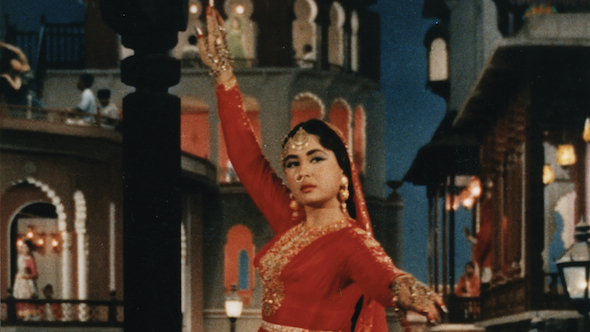The song Inhi logon ne le leena dupatta mera song was perhaps the most widely celebrated number of Pakeezah which gained instant popularity. It defined the genre of Bollywood Mujras since its release.
Kamal Amrohi’s Pakeezah took more than a decade to complete. Its composer died during the making of the film, and the lead actress passed away a few weeks after the release of the film. The film and its soundtrack eventually turned out to be a huge success.
Tuned by Ghulam Muhammad, the song is based on Raag Yaman but evokes a playful spirit and ironically, the lyrics describe the pain and sorrow of a Tawaif (courtesan) in the patriarchal society that builds brothels and ‘take her dignity away’.
It was first shot in black and white on a much younger Meena Kumar around 1956. However, the film went into cold storage for some time and the song had to be filmed again in colour.
https://youtu.be/69XyuakndNg
The song is commonly thought to be penned down by Majrooh Sultanpuri, but it’s surprising that this song with the same tune and lyrics was used many years earlier by Pt. Gobindram, who composed it for the film Himmat (1941) in Shamshad Begum’s voice. It is believed that this song was probably popular among the tawaifs of that era and Pt. Gobindram based his song on that. At that time, Aziz Kashmiri was credited with the lyrics.
“To persuade her lover, she implores him to ask three characters in the song to confirm that her virtue was soiled against her will: the cloth merchant, the cloth dyer, and the constable.”
https://www.youtube.com/watch?v=F0QpprJJ1Ig
A couple of years later, Pt. Gobindram used it again in a comic situation in Aabroo (1943). It’s not clear why this time, it was Tanvir Naqvi who got the credit for the same lyrics despite the fact that the lyrics were almost exactly the same except for an opening verse.
https://youtu.be/4UzZlIZwQ9Q
Some have argued that the song was originally written by Amir Khusro. However, there is no substantial evidence for this claim.
“Deep-seated stigmas surround tawaifs and their profession, but what is the driving force behind our obsession with the story of a courtesan with a heart of gold?”
There are also significant similarities of this tune with some other songs. Film Achhut Kanya (1936) had a ‘performance’ song in a village fair. The song Choodi main laaya anmol had almost the same tune. But the credit for the tune was given to Saraswati Devi.
https://youtu.be/3D2QL-fXtLU
There are three other songs from that era that are believed to have some similarities with the song.
https://en.dailypakistan.com.pk/opinion/blog/meena-kumari-woman-who-gave-new-definition-to-womanhood/
Maza Mila Hai from movie Sartaj (1950) also sounds very similar. It was sung by Lata and Shamshad and composed by Husnalal Bhagatram.
https://youtu.be/x122xMkLwN4
Lehenga mangwa de re babu from film Beti (1969) – Asha Bhosle & Usha Mangeshkar – replicated the initial notes of the song. It was composed by Sonik Omi and written by Shakeel Badayuni.
https://youtu.be/vAOuham09Sg
Dil Na Kisi Ka Jaaye from movie Kshatriya (1993) was composed by Laxmikant Pyarelal. Not only is the tune of the mukhda the same as the Beti song, even the first antara follows a similar pattern.
https://youtu.be/OjMapNmkG00
It’s also surprising and intriguing that all these songs – with almost same tunes and lyrics – were picturized on tawaifs from the early 30s. Many musicologists that I talked to agreed on the fact that the tune of this song was based on a popular folk Bhajan of Awadh region. (U.P). Many other famous compositions of Naushad were inspired by folk tunes of Awadh who himself was from the region.
“Despite the conservative social climate of the 1960s and 1970s, why did courtesan-based films (e.g. Pakeezah, Mughal-e-Azam, Amar Prem) resonate intimately with our audiences?”
Not much research has been done on this. But it is very likely that the song was a popular Mujra song among tawaifs of that time. The song reflects our history and tells the story of tawaifs of yesterday.
In the song, the tawaif laments how the men around her have stolen her innocence and modesty, which is symbolically represented by the loss of her Dupatta. To persuade her lover, she implores him to ask three characters in the song to confirm that her virtue was soiled against her will: the cloth merchant, the cloth dyer, and the constable.
https://youtu.be/lEm7GwR3hvM
The irony is that the red colour of the lost scarf and Meena Kumari’s outfit is the colour of the bride on her wedding day. Yet, the audience is acutely aware that a tawaif in such a position will provoke condemnation and disgust for attempting to engage in the conventional structures of love and marriage established by the society around her.
But the real question I want to ask is: Despite the conservative social climate of the 1960s and 1970s, why did courtesan-based films (e.g. Pakeezah, Mughal-e-Azam, Amar Prem) resonate intimately with our audiences? Deep-seated stigmas surround tawaifs and their profession, but what is the driving force behind our obsession with the story of a courtesan with a heart of gold?
Pakeezah was a story of a ‘pure’, love-seeking woman and cemented that lasting popular image of the heroine: deep sorrow, longing and unsaid verses in those beautiful eyes.














